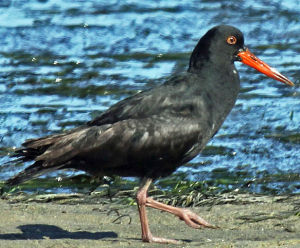The African Oystercatcher or African Black Oystercatcher, (Haematopus moquini) is a large wader which breeds on the rocky coasts and islands of southern Africa. It is the largest of all the species.
It has a coastal breeding range which stretches from Lüderitz in Namibia to Mazeppa Bay in the Eastern Cape of South Africa. The total population is estimated at 5,000 – 6,000 individuals, with about half occurring along the Western Cape coastline. It is listed as Near Threatened owing to its small population.
The species forages exclusively in the intertidal zone and is found on mainland rocky and sandy shores during the non-breeding season. Its diet includes limpets and mussels, but also polychaetes, whelks and crustaceans.
The nest is a scrape in sand where possible, or eggs are laid on bare rock and is usually situated within 30m of the high water mark. Unfortunately the Oystercatcher breeding season coincides with summer and summer holiday periods when use of the coast is at its peak. As a result in many areas birds are unable to breed successfully due to disturbance.
The African black oystercatcher has glossy black plumage, which contrasts with its red eye, and bright orangey-red eye-ring and long bill. The sturdy legs are a deep pinkish-red.





